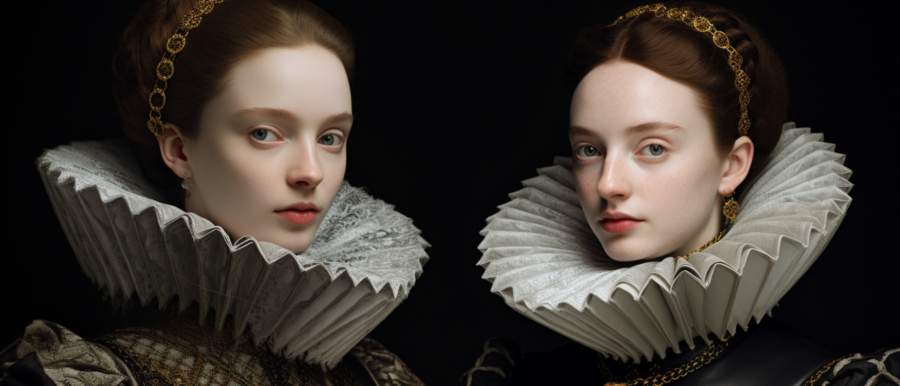Elizabethan Collars: 16th Century English Elegance

A Brief History of the Elizabethan Collar
Picture this: the year is 1562, and you've just received an invitation to a party at the royal court. What do you wear to impress Queen Elizabeth I and her courtiers? Why, an Elizabethan collar, of course! These extravagant neck ruffs were all the rage in 16th century England, symbolizing status, wealth, and refinement. The bigger and more elaborate the collar, the more fabulous you were considered to be.Originally inspired by the pleated linen collars worn by Spanish nobility, Elizabethan collars quickly took on a life of their own in England. The collars evolved from modest beginnings to elaborate, multi-tiered creations, resembling the petals of a flower or a halo surrounding the wearer's head. They were starched and wired to maintain their shape and could be worn with or without a matching ruff to cover the neck and shoulders. The peak of Elizabethan collar fashion came in the late 16th century when the "cartwheel ruff" - a large, circular collar with many layers of pleats - became popular among the upper class.
Constructing an Elizabethan Collar
If you're anything like me, you're probably wondering how these gravity-defying collars were constructed. After all, it's not every day that you see someone wearing a neck accessory that looks like it could double as a satellite dish. The secret to Elizabethan collar construction lies in the use of starch and wires.To make an Elizabethan collar, a long strip of linen or lawn (a fine, lightweight fabric) would be tightly pleated, with each pleat containing anywhere from 2 to 6 layers of fabric. This would create a dense, accordion-like effect. The pleats were often stitched or held in place with pins, and then the entire collar would be soaked in a mixture of water and starch. The starch not only stiffened the fabric, but it also helped to create a smooth, shiny surface that was more resistant to dirt and grime.
Once the starch had dried, the collar would be carefully shaped around a series of wires that had been sewn into the fabric. These wires provided the necessary structure to support the collar's elaborate design. The wires would be bent into various shapes - circles, crescents, hearts, or even letters of the alphabet - and attached to the wearer's doublet, gown, or corset with pins, ribbons, or hooks.
Practicality, or Lack Thereof
Sure, Elizabethan collars certainly made a statement, but were they practical? In a word, no. These large, delicate collars were cumbersome and difficult to maintain. Their starched surfaces attracted dust and dirt, requiring frequent laundering. Additionally, the collars limited the wearer's mobility and obscured their peripheral vision, which must have made attending court functions and participating in social events somewhat challenging.That said, practicality was not the point of Elizabethan collars. These collars were all about status and image. They were a visual representation of one's wealth, and the more elaborate the collar, the more powerful and influential the wearer was perceived to be.
Modern Interpretations and Uses
While Elizabethan collars may not be the most practical fashion accessory, their unique and eye-catching design has endured and continues to inspire modern fashion. Variations on the Elizabethan collar have appeared on high-fashion runways, in films and television shows, and even in the world of cosplay and historical reenactments.- In the world of haute couture, designers such as Alexander McQueen and Valentino have created garments featuring exaggerated collars reminiscent of the Elizabethan era.
- In the realm of film and television, Elizabethan collars have appeared in productions such as "Shakespeare in Love" and "The Tudors," adding a touch of historical accuracy and drama to the costumes.
- For those interested in cosplay or historical reenactments, recreating an accurate Elizabethan collar can be a fun and challenging project. There are numerous tutorials and patterns available online to guide you in your quest to create the perfect ruff.
Article kindly provided by foreverinfashion.org
Latest Articles
- The Psychology of Tattoo Aesthetics: Why Certain Imagery Resonates
- Style That Works With Your Body, Not Against It
- Fashion Tourism on Wheels: Curated Shopping Routes Led by Chauffeur Guides
- The Charm of Certainty in a World of Indecision
- Can an Everyday T-Shirt Be Turned into a Modern Heirloom?
- Color, Ceremony, and the Psychology of Celebration
- Styling Graphic T-Shirts for Different Body Types
- Getting Kids to Wear Their Hats Without a Bribe or a Meltdown
- Mastering the Art of Being the Unnoticed Photographer
- Quiet Sportswear Moves Loudly
- Fashion's Most Misunderstood Color Is Brown
- Weight Matters When Cotton Gets Real
- SKU's Out for Summer: Why Your Warehouse Is Melting Down
- Ink as Accessory - How Tattoos Are Replacing Jewelry in Modern Style
- Accessories
- Jewellery
- Footwear
- Skirts and Dresses
- Shirts and Blouses
- Beauty and Makeup
- Fashion Photography
- Sustainable Fashion
- Street Style
- Fashion History
- Fashion Business
- Fashion Styling
- Fashion Events
- Plus-Size Fashion
- Men's Fashion
- Women's Fashion
- Fashion Blogging
- Fashion Trends
- Fashion Retailers
- Fashion Tips and Advice
- Fashion Business Startups
- Fashion Around the World
- Lingerie
- Sportswear
- Weddings

